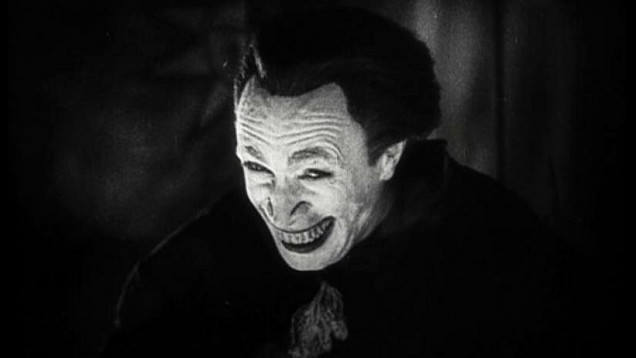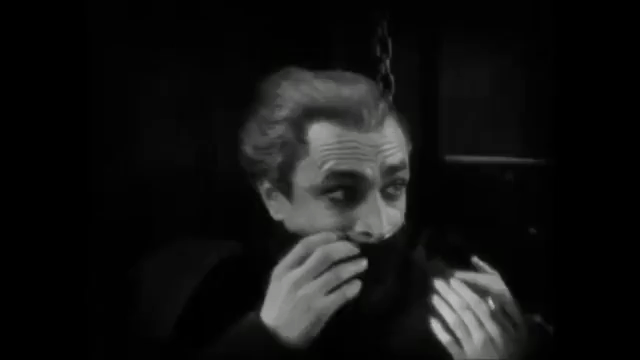Now you’ve seen the Joker trailer, here’s the crazy film that inspired this iconic villain

Did you know the character of the Joker was inspired by a trippy 1928 German film called The Man Who Laughs? Critic Luke Buckmaster explores this iconic character’s bat shit crazy origins.
How about that Joker trailer? Just when we thought we’d seen enough of Gotham City’s maniacal clown-like sadist, whose presence is ubiquitous in popular culture, along comes Joaquin Phoenix. The famously downbeat, gravitas-weeping star has got us all excited for yet another Joker movie featuring yet another actor, carrying on like a demonic pork chop from beneath inch-thick smeared face paint.
With memory of Heath Ledger’s brilliant, hellzapoppin turn in The Dark Knight still fresh, as well as less impressive efforts lingering in the zeitgeist such as Jared Leto’s performance in the abysmal Suicide Squad, making the prospect of another Joker movie interesting is alone a significant achievement. It’s almost like Phoenix is the greatest actor of his generation.
I will leave others to talk up or talk down how awesome/terrible/life changing/soul destroying Phoenix will be; such sentiments are the coin of the realm on social media. Instead I want to use this moment of renewed interest in the character to remind readers of the Joker’s connection to a production that first arrived in cinemas nearly a century ago. It is an amazing 1928 German Expressionist film called The Man Who Laughs, which doesn’t seem to be all that well remembered let alone celebrated. You can order a DVD of it without any problems, or there is a version of it on YouTube.

In the current, superhero-inundated times, this gasp-inducing classic deserves to (re) emerge as a key text. The creators of the Joker were inspired by the film’s protagonist, a pitiable soul named Gwynplaine, who as a child was captured and disfigured by an evil comprachico. The bastard had a large smile carved into Gwynplaine’s face with a knife, giving him the appearance of somebody who is always laughing (hence the title). Gwynplaine’s home is a travelling circus, where he is one of the star ‘freaks’.
This deeply sorrowful character was brought to life by German actor Conrad Veidt, whose performance captures the film’s dark and troubled heart, taking the audience on an emotional journey marked by tragedy, despair and ultimately hope. It is Veidt’s face (in character) that proved influential to the creation of Gothic city’s most iconic villain. Bob Kane, who is credited with co-creating the Joker with Bill Finger and Jerry Robinson, said in a 1994 interview:
“Bill Finger and I created The Joker. Bill was the writer. Jerry Robinson came to me with a playing card of The Joker. That’s the way I sum it up. But he looks like Conrad Veidt – you know, the actor in The Man Who Laughs, by Victor Hugo. There’s a photo of Conrad Veidt in my biography, Batman & Me. So Bill Finger has a book with a photograph of Conrad Veidt and showed it to me and said, ‘Here’s the Joker.”
Director Paul Leni imbued the intensely trippy The Man Who Laughs with an atmosphere so rich and moody watching it feels like a visceral experience, as if the entire film exists in that moment when you open an oven door and get your face blasted with hot air. The late American critic Roger Ebert was on the money when he described it as a melodrama “so steeped in Expressionist gloom that it plays like a horror film.”
The Man Who Laughs arrived at the tail end of the 1920s, the decade that produced many of the finest and most influential silent pictures – including Sunrise: A Song of Two Humans, Metropolis, The Passion of Joan of Arc, The Last Laugh and The General. I rewatched the film recently, around the time I revisited Disney’s original Dumbo movie in the lead-up to Tim Burton’s recent remake.
A shot in The Man Who Laughs of an elephant in a circus made me think: this is a film Disney’s famously problematic production could have learned from. Leni explores a decent man ostracised for the way he looks: judged, scorned, humiliated; tossed onto the trash heap of society. Yet The Man Who Laughs does not (unlike the 1941 version of Dumbo – Burton’s film is a different kettle of fish) use its protagonist as a pity magnet, evoking base responses from the audience.
Gwynplaine is a complex character; a figure of compassion and humanity. If Heath Ledger’s Joker were to break into this universe and ask its inhabitants “Why so serious?”, the answer would be that the world, as Leni powerfully illustrates (particularly in the context of exploitative entertainment) can be a brutally nasty place, populated by dumb beasts addicted to dehumanising spectacle.
Watch this amazing film and – I promise – it will never leave you.

















